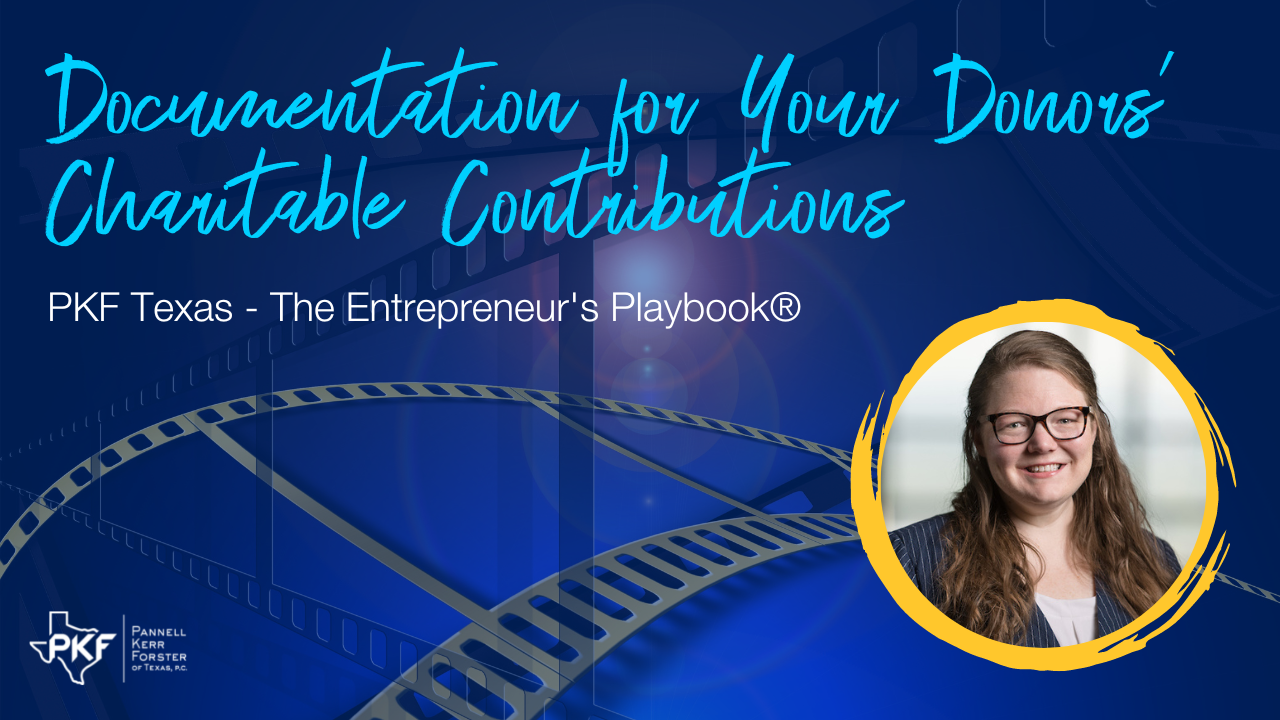Documentation for Your Donors’ Charitable Contributions

Does your not-for-profit organization have generous donors? Make sure you’re providing the correct documentation for their charitable contributions to maintain your tax-exempt status. In this episode of PKF Texas – The Entrepreneur’s Playbook®, Tax Director Emily Smikal, CPA, walks us through several scenarios and how to handle them.
Jen: This is the PKF Texas – Entrepreneur’s Playbook®. I’m Jen Lemanski and I’m back again with Emily Smikal, a Tax Director and one of our Approachable Advisors™ here at PKF Texas. Emily, welcome back to the Playbook.
Emily: Thanks, Jen. Happy to be here.
Tax-Deductible Charitable Contributions
Jen: So, it’s my understanding that a tax-exempt organization can receive tax-deductible contributions. Is that correct?
Emily: Well, it’s not the case for all tax-exempt organizations. It is true that 501(c)(3) organizations can receive charitable contributions that are deductible to the donor.
Jen: So, if you’re making a donation, how would you check that?
Emily: One, a donor could request that the organization provide documentation of their tax-exempt status. Any 501(c)(3) organization will have a letter from the IRS that states that they have been recognized as such, or a donor could actually look at the tax-exempt organization search on their IRS website or on GuideStar.
Scenarios for Charitable Contributions
Jen: So, what kind of documentation should they be looking for – or can they ask an organization for?
Emily: There should be a documentation given upon their donation. And that threshold requirement does vary depending on the type of donation and also whether or not the donor receives anything in exchange. So, today we’re just going to talk about monetary donations, but if any single donation of $250 or more is given, then that requires a written acknowledgement from the organization. However, if the donor receives anything in exchange – goods or services – for their donation, that requirement has decreased to $75.
Jen: Oh, wow. So, is that a common scenario then?
Emily: It is. And a really common example is purchasing a ticket to a charity gala. So, with the purchase of that ticket, a donor is likely going to receive food and entertainment at that gala. And those things have a value attached to them that the donor is considered to be receiving in exchange. So, in those situations, it’s very important that the organization includes both the amount of donation on the receipt, as well as the value of the goods and services that the donor received. Because in that case, the donor’s tax deduction is limited to the excess of their donation over the fair value that is disclosed on the receipt.
Jen: So, I’ve seen on receipts often it will have a line item that says FMV, is that correct?
Emily: That’s right. That’s that “fair market value” that the donor received in exchange for their gift.
Jen: Perfect. Well, we’ll get you to talk a little bit more about some more not-for-profit topics. Sound good?
Emily: Sounds great. Thank you.
Jen: This has been another thought leadership production brought to you by PKF Texas – The Entrepreneur’s Playbook®. For more information about charitable contributions and other topics, visit www.pkftexas.com/NotForProfit. Tune in next week for another chapter.

